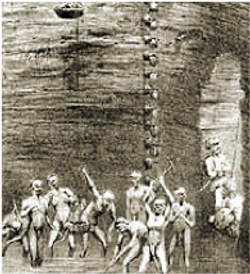
Diamonds
Worth Pennies or Millions?

From Stones to Gems: A History of the Diamond Trade
The diamond is one of the most coveted stones in human history. Much of this gem’s early history remains unknown (Alam, 2014), but evidence has indicated diamond trading in India as early as the 4th Century BC among the upper class, a consistent trend throughout the earlier years of diamond’s trading history (“History of Diamonds”, 2014 ). Although diamonds were traded in the Silk Road, diamonds did not have a prominent influence in Europe until about the 15th century (Gorelick and Gwinnet, 2014). The trade circuit in the 14th century most likley contributed to this shift since trade encompassed areas from Asia, including diamond- producing India, to Europe (Abu-Lughood). This trade trend depicts the fairly equal market place between the East and West before the West began to surpass the East. The 15th century marks the beginning of diamonds’ debut in the European marketplace, with evidence of its presence in the markets of Venice (“Diamond History and Lore”, 2014). The diamond was primarily used as a tool to engrave other gems, such as sapphires, in Europe during the 1400’s and there has not been much evidence suggesting its use for adornment during this time period (Gorelick and Gwinnet, 2014).
India was still Europe’s only known source of diamonds in the 17th century when the diamond industry began revitalizing (Alam, 2014). As the first photo below shows, the area of Golconda area was a very popular diamond site, at the heart of India. Since most records originate from the British and Dutch, much of the diamond’s history is Eurocentric (Alam, 2014). Regardless, it is evident that diamond mining had a significant impact on the growth India’s society and provided opportunity for prosperity to the surrounding villages (Alam, 2014). As European interest in diamonds grew, monopolies began to form. The Dutch, for example, claimed a monopoly in the Southern district of Gingi in 1643 by establishing a contract excluding the English, Portuguese, and Danish from the trading process (Alam, 2014). The Dutch’s actions are fitting for this time period, for colonization of India was of great interest to the English, Portuguese and Spanish, and French powers (Marks,2014). The wide acceptance of mercantilism as means of conducting economic duties significantly influenced the actions of these powerful nations, prompting the nations to establish their companies, such as diamond mining, with abandon and create monopolies.
Around 1730, diamonds were discovered in Brazil and the world’s attention shifted away from India and towards Brazil (“History of Diamonds”, 2014). India’s diamond mines had begun to become depleted, a common problem seen throughout history, which provided Brazil the perfect opportunity for dominance in the diamond market for about 150 years (“Diamond History and Lore”, 2014). Brazil’s success in the diamond market was undoubtedly due to the novelties of the Industrial Revolution. The Industrial Revolution provided European powers the innovations, such as coal and steamboats, needed to transport heavy commodity overseas (Marks, 2007). The Industrial Revolution also played a notable role in the trade of slaves, shown in the third photo below. Although monopolies were present during this era, the majority the diamond trading system centered on free trade until the establishment of diamond syndicate in 1889 after the discovery of diamonds in South Africa (Davis 258). The establishment of the syndicate marked the beginning of capitalism in the diamond market brought about by business man Cecil Rhodes.
The discovery of diamonds in Africa in the 1870’s has played a significant role in the diamond industry and has become the source of some of the world’s largest diamond mines (Davis, 2014). The unearthing of these African mines also had a significant impact of world interest in diamonds. During the late 1700’s, interest in diamonds was declining, mostly due to historical events affecting the distribution of wealth, such as the French Revolution (“Diamond History and Lore”, 2014). When the bountiful source of diamonds in the mines of Africa were discovered, there was an initial rush to excavate the gem (“History of Diamonds”, 2014). Interestingly, diamond supply was so great, the diamond lost its prestige among the upper class and other gems, such as sapphires and rubies, became more coveted among the wealthier classes (“History of Diamonds”, 2014).
Entrepreneur Cecil Rhode’s has been credited for the creation of the modern diamond market in 1888 with the establishment of his business, De Beers Consolidated Mines Limited (“Diamond History and Lore”, 2014). It is during this time diamond mining moved to a large-scale labor intensive work with a capitalist mentality (Davis, 2014). This implementation of labor work is an example of the early habits of European colonialism often seen throughout history (Diamond). De Beers controlled diamond supply to increase its rarity and expense, however the value of the diamond continued to decrease in the early 1900’s (“History of Diamonds”, 2014). Furthermore, diamonds were becoming more scare in African mines and new technologies and diamond mining techniques were necessary to maximize efficiency (“Diamond History and Lore”, 2014). The survival of the diamond industry however, relied on strategic marketing, the success of which has been mostly attributed to Rhode (Davis, 2014). The success of marketing is evident in the sale of diamonds, in the 1920’s, only about 3 million carats of rough diamonds were produced annually, but in the 1970’s the figure increased to about 50 million carats (“Diamond History and Lore”, 2014). Another important note was the increase of world sources in diamonds. By 2000, South Africa, Russia, Zaire, Botswana, Australia and Canada were all known to have diamonds and have contributed as a source for diamonds (“Diamond History and Lore”, 2014). The last photo below illustrates the diamond mining industry today.
 Ancient India Mines |  Ancient India Mines |
|---|---|
 Brazilian Slaves |  Diamond Sources Map |